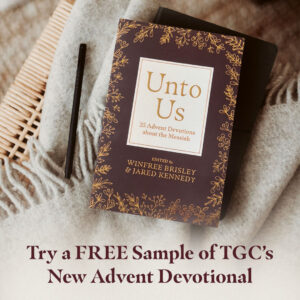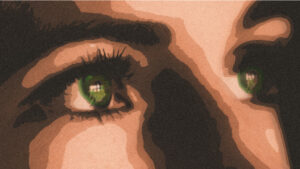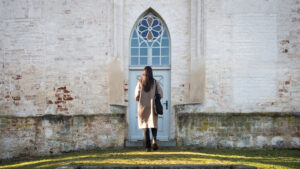Many of us who have seen “Christian paintings,” watched “Christian movies,” and heard “Christian music” may be skeptical about Christian art. As Gregory Thornbury has quipped, “Christianity is the greatest of all nouns, but the lamest of all adjectives.”
But is there a way to envision “Christian art” as something more than misty fairytale cottages or contrived plotlines where typecast God-haters join in a tearful Jesus anthem before the credits roll?
I believe there is, but it won’t happen unless we first develop a more robust theology of art. Here is a brief, two-minute sketch of what that might look like.
God Is an Artist
The first time we meet God in the story of Scripture, we meet him as an Artist. “Created” is the first verb in the first sentence on the Bible’s first page. Out of the flurry of God’s imagination, the heavens and the earth burst into existence and teem with diversity and beauty. God could have easily spoken a monochrome cosmos into being. He could have made an all-gray universe—gray planets, gray animals, gray-on-gray rainbows in a gray sky. Even oranges would be called “grays.” This Graytopia could’ve been perfectly efficient and functional from an engineering perspective. Why, then, make our multi-hued universe? Why the color spectrum? Why red strawberries, orange oranges, and yellow lemons? Why mandarinfish, peacocks, and chameleons? Because, as Genesis 1 repeats seven times, “God saw that it was good.” Evidently, God cares about more than efficiency and functionality. He also cares about beauty.
God cares about more than efficiency and functionality. He also cares about beauty.
Taylor University philosophy professor James Spiegel has made the case that when God said “it was good,” he was not making a moral, legal, political, or prudential claim. He was making an aesthetic claim. It’s not like saying that the boy who ate all his vegetables “was good” for obeying Mommy, or the Magna Carta “was good” for society, or the Large Hadron Collider “was good” for quantum research. It’s more like beholding a Titian canvas or a sunset over the Pacific and saying, “That’s good.” And God made this aesthetic declaration even before he made Adam and Eve! It follows, then, that something can be truly beautiful even if no human being is around to behold and declare it so. Beauty, then, is not merely something we as humans dream up (though thankfully we can); it’s also something we can discover, something beyond and even before us.
We Don’t Fabricate Beauty. We Find It.
This means when the Hubble satellite left our atmosphere and started relaying space pictures back to us, there was nothing arbitrary or artificial when we collectively exhaled, “Beautiful!” When human beings over the last 30 years first beheld the sprawling fuchsia clouds of the Orion Nebula, the cobalt pupil and auburn iris of the Helix Nebula, or the somber towering gas pillars of the Eagle Nebula—with their speckles of pink fire and wispy sea-green auras—we did not fabricate beauty. We found it. They were beautiful long before Hubble left our atmosphere, and they would stay beautiful even if we all went blind tomorrow.
Why? In a biblical view of the universe, it is because God cares about beauty and declares things beautiful even when we cannot. Beauty is not merely in the eye of the beholders—us—but in the eye of the Beholder. From this perspective, we enter the world not merely to impose our ever-changing constructs of beauty on some aesthetic void. Beauty is already there, and it will impose itself on us and refashion our constructs into something more noble and towering and true, if we dare let it.
Beauty is not merely in the eye of the beholders—us—but in the eye of the Beholder.
Creativity and Christlikeness
The first command from God to a human being was to do something creative: “Name the animals.” Next come commands to be fruitful and multiply, to fill the earth and steward creation—God’s call to make something of the world. Later Bezalel and his sons live out that calling as God’s Spirit gave them the aesthetic skill to make Temple décor. Israel’s God was not worshiped in a drab, hollow cube. Then we find invitations to worship the creative God creatively: “Sing to him a new song, play skillfully on strings with loud shouts.” “Sing praises to the LORD with the lyre, with the lyre and the sound of melody.” “Praise his name with dancing” (Pss. 33:3; 98:5; 149:3).
God never limited himself to didactic prose when revealing himself to Israel. He tells multisensory truth, truth with fire-cooking meat, blood painted on doorposts, talking donkeys, vomiting fish, hungry bears, wandering goats, crucified snakes, burning plants, thunder, smoke, rocks, bugs, milk, and honey. He tells truth in vivid images—skeletons coming to life, apocalyptic sea monsters, and menstrual rags. Then there’s the prophetic performance art. Isaiah wanders naked for three years. Hosea marries a well-known harlot.
God never limited himself to didactic prose when revealing himself to Israel.
Turning to the New Testament, we learn that the masterful Creator we met in Genesis 1 is actually Jesus Christ (John 1:3; Col. 1:15–17; and Heb. 1:8–13). Glowing space nebulae, rainbows, the flavor of watermelon, and coffee beans were his idea (in creative collaboration with the Father and the Spirit). The Son took on created flesh. He spent most of his career as a tekton, a craftsman who could make both small and large-scale projects with stone, wood, and metal. Then when his public ministry started, Jesus taught mostly in parables, painting mental pictures that have lived in our imagination for more than two millennia. His greatest commandment to love God with all of ourselves includes the imaginative and creative parts too, as it most certainly did for him. Creativity and Christlikeness go hand in hand.
This article is adapted from REFLECT: Becoming Yourself by Mirroring the Greatest Person in History (Lexham Press, 2019) by Thaddeus Williams.
Try Before You Buy: FREE Sample of TGC’s New Advent Devotional

Choosing the right Advent daily devotional can be tough when there are so many options. We want to make it easier for you by giving you a FREE sample of TGC’s brand-new Advent devotional today.
Unto Us is designed to help you ponder the many meanings of this season. Written by TGC staff, it offers daily Scripture readings, reflections, and questions to ponder. We’ll send you a free sample of the first five days so you can try it out before purchasing it for yourself or your church.

































